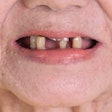
The risk for head and neck cancer (HNC) was almost 50% higher in patients with diabetes mellitus (DM) than in individuals without DM in a new study in JAMA Otolaryngology -- Head & Neck Surgery (July 24, 2014). The estimated risk for HNC was also higher for male patients and people ages 40 to 65.
The researchers used Taiwan's National Health Insurance Research Database to compare the records of more than 89,000 patients who were newly diagnosed with diabetes mellitus with those of control patients matched by age, sex, and comorbidities. They examined the overall risk and the specific types and sites of HNC in patients with DM.
The data contained insurance claims data for 23.3 million beneficiaries from 1996 through 2011 and included patients with a first-time diagnosis of DM in 2002. The comorbidities included obesity, hypertension, coronary artery disease, chronic kidney disease, and chronic obstructive pulmonary disease.
The researchers found that patients with newly diagnosed DM had an overall incidence of HNC 1.47 times higher than did control patients without DM matched for age, sex, geographic distribution, monthly income, and comorbidities.
"We believe that such a study will provide useful information to physicians planning patient follow-ups and researchers working to identify the potential carcinogenic effects of DM," the researchers wrote.
Background
Head and neck cancer is the sixth most common type of cancer, accounting for about 6% of all cases and for an estimated 650,000 new cancer cases and 350,000 cancer deaths worldwide annually. It encompasses epithelial malignant tumors that arise in the paranasal sinuses, nasal cavity, oral cavity, pharynx, and larynx.
An increasing body of evidence suggests that certain types of cancers are more common in people with diabetes mellitus. Previous studies have reported elevated risks of cancers of the liver, biliary tract, pancreas, stomach, colorectum, kidney, bladder, breast, and endometrium but a decreased risk of prostate cancer.
Exposure to high levels of insulin and insulin-like growth factors (IGFs) in DM increases cellular proliferation and activation of the oncogenic epidermal growth factor receptor, according to the researchers who undertook this retrospective, population-based study. Furthermore, IGF and its receptors have mitogenic and antiapoptotic effects that can cause malignant transformation. Another possible explanation is hyperglycemia, which may directly promote tumors as cancer cells rely on increased glucose consumption.
Results
The mean age in the diabetes mellitus group at the diagnosis of head and neck cancer was 55 years. The incidence of HNC was significantly higher in DM patients ages 40 to 65 than in younger patients, and men had a higher risk than women.
The researchers found that the most prevalent site of HNC in patients with DM was the oral cavity (57.1%) with the nasopharynx (15.3%) the second most prevalent site. Patients with newly diagnosed DM were associated with an increased risk of nasopharyngeal cancer, the study authors noted.
The overall survival for patients without HNC was significantly higher among the control patients than in the patients with DM. However, there was no significant difference in overall survival between patients in the DM and non-DM cohorts who subsequently developed HNC.
Without oral cavity cancer, oropharyngeal cancer, and nasopharyngeal carcinoma, the overall survival for patients was significantly higher in the DM group, according to the study authors. No significant difference was found in overall survival between patients in the DM and non-DM groups who subsequently developed oral cavity cancer, oropharyngeal cancer, and nasopharynx cancer.
Possible mechanisms
According to the researchers, possible mechanisms for the link between diabetes mellitus and head and neck cancer include the following:
- Shared genetic risk factors
- Epigenetic modifications of inherited or acquired genetic mutations
- Long-term exposure to hyperinsulinemia, which leads to breast cancer
- Exposure to high levels of insulin and insulin-like growth factor, which can increase cellular proliferation
- Metabolic dysfunctions parallel to diabetes
A limitation of the study is that several suspected risk factors for HNC, such as patients' histories of using alcohol, smoking tobacco, and physical activity, were not available in the database, the study authors noted.


















